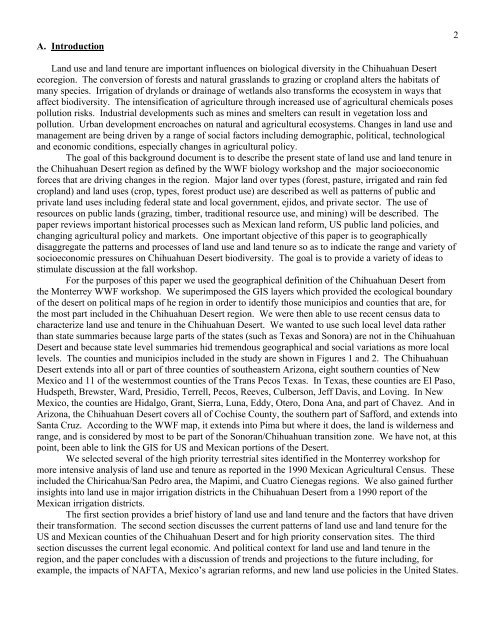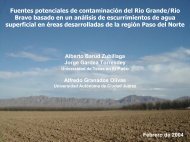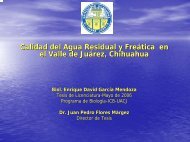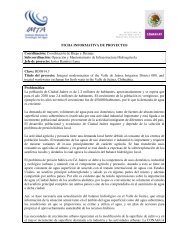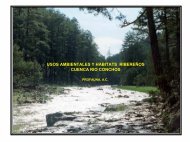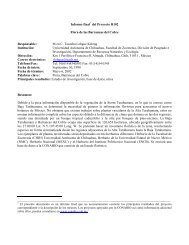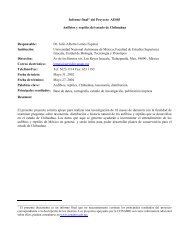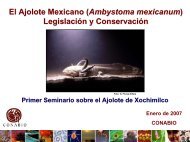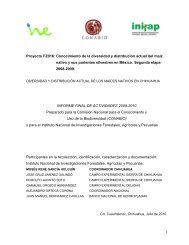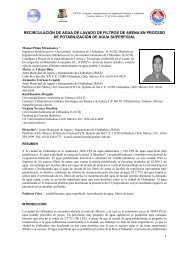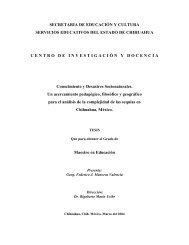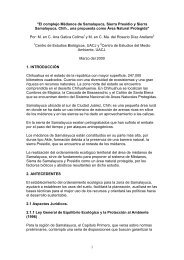land use and land tenure change in the - El Colegio de Chihuahua
land use and land tenure change in the - El Colegio de Chihuahua
land use and land tenure change in the - El Colegio de Chihuahua
Create successful ePaper yourself
Turn your PDF publications into a flip-book with our unique Google optimized e-Paper software.
A. Introduction2L<strong>and</strong> <strong>use</strong> <strong>and</strong> <strong>l<strong>and</strong></strong> <strong>tenure</strong> are important <strong>in</strong>fluences on biological diversity <strong>in</strong> <strong>the</strong> <strong>Chihuahua</strong>n Desertecoregion. The conversion of forests <strong>and</strong> natural grass<strong>l<strong>and</strong></strong>s to graz<strong>in</strong>g or crop<strong>l<strong>and</strong></strong> alters <strong>the</strong> habitats ofmany species. Irrigation of dry<strong>l<strong>and</strong></strong>s or dra<strong>in</strong>age of wet<strong>l<strong>and</strong></strong>s also transforms <strong>the</strong> ecosystem <strong>in</strong> ways thataffect biodiversity. The <strong>in</strong>tensification of agriculture through <strong>in</strong>creased <strong>use</strong> of agricultural chemicals posespollution risks. Industrial <strong>de</strong>velopments such as m<strong>in</strong>es <strong>and</strong> smelters can result <strong>in</strong> vegetation loss <strong>and</strong>pollution. Urban <strong>de</strong>velopment encroaches on natural <strong>and</strong> agricultural ecosystems. Changes <strong>in</strong> <strong>l<strong>and</strong></strong> <strong>use</strong> <strong>and</strong>management are be<strong>in</strong>g driven by a range of social factors <strong>in</strong>clud<strong>in</strong>g <strong>de</strong>mographic, political, technologica<strong>l<strong>and</strong></strong> economic conditions, especially <strong>change</strong>s <strong>in</strong> agricultural policy.The goal of this background document is to <strong>de</strong>scribe <strong>the</strong> present state of <strong>l<strong>and</strong></strong> <strong>use</strong> <strong>and</strong> <strong>l<strong>and</strong></strong> <strong>tenure</strong> <strong>in</strong><strong>the</strong> <strong>Chihuahua</strong>n Desert region as <strong>de</strong>f<strong>in</strong>ed by <strong>the</strong> WWF biology workshop <strong>and</strong> <strong>the</strong> major socioeconomicforces that are driv<strong>in</strong>g <strong>change</strong>s <strong>in</strong> <strong>the</strong> region. Major <strong>l<strong>and</strong></strong> over types (forest, pasture, irrigated <strong>and</strong> ra<strong>in</strong> fedcrop<strong>l<strong>and</strong></strong>) <strong>and</strong> <strong>l<strong>and</strong></strong> <strong>use</strong>s (crop, types, forest product <strong>use</strong>) are <strong>de</strong>scribed as well as patterns of public <strong>and</strong>private <strong>l<strong>and</strong></strong> <strong>use</strong>s <strong>in</strong>clud<strong>in</strong>g fe<strong>de</strong>ral state <strong>and</strong> local government, ejidos, <strong>and</strong> private sector. The <strong>use</strong> ofresources on public <strong>l<strong>and</strong></strong>s (graz<strong>in</strong>g, timber, traditional resource <strong>use</strong>, <strong>and</strong> m<strong>in</strong><strong>in</strong>g) will be <strong>de</strong>scribed. Thepaper reviews important historical processes such as Mexican <strong>l<strong>and</strong></strong> reform, US public <strong>l<strong>and</strong></strong> policies, <strong>and</strong>chang<strong>in</strong>g agricultural policy <strong>and</strong> markets. One important objective of this paper is to geographicallydisaggregate <strong>the</strong> patterns <strong>and</strong> processes of <strong>l<strong>and</strong></strong> <strong>use</strong> <strong>and</strong> <strong>l<strong>and</strong></strong> <strong>tenure</strong> so as to <strong>in</strong>dicate <strong>the</strong> range <strong>and</strong> variety ofsocioeconomic pressures on <strong>Chihuahua</strong>n Desert biodiversity. The goal is to provi<strong>de</strong> a variety of i<strong>de</strong>as tostimulate discussion at <strong>the</strong> fall workshop.For <strong>the</strong> purposes of this paper we <strong>use</strong>d <strong>the</strong> geographical <strong>de</strong>f<strong>in</strong>ition of <strong>the</strong> <strong>Chihuahua</strong>n Desert from<strong>the</strong> Monterrey WWF workshop. We superimposed <strong>the</strong> GIS layers which provi<strong>de</strong>d <strong>the</strong> ecological boundaryof <strong>the</strong> <strong>de</strong>sert on political maps of he region <strong>in</strong> or<strong>de</strong>r to i<strong>de</strong>ntify those municipios <strong>and</strong> counties that are, for<strong>the</strong> most part <strong>in</strong>clu<strong>de</strong>d <strong>in</strong> <strong>the</strong> <strong>Chihuahua</strong>n Desert region. We were <strong>the</strong>n able to <strong>use</strong> recent census data tocharacterize <strong>l<strong>and</strong></strong> <strong>use</strong> <strong>and</strong> <strong>tenure</strong> <strong>in</strong> <strong>the</strong> <strong>Chihuahua</strong>n Desert. We wanted to <strong>use</strong> such local level data ra<strong>the</strong>rthan state summaries beca<strong>use</strong> large parts of <strong>the</strong> states (such as Texas <strong>and</strong> Sonora) are not <strong>in</strong> <strong>the</strong> <strong>Chihuahua</strong>nDesert <strong>and</strong> beca<strong>use</strong> state level summaries hid tremendous geographical <strong>and</strong> social variations as more locallevels. The counties <strong>and</strong> municipios <strong>in</strong>clu<strong>de</strong>d <strong>in</strong> <strong>the</strong> study are shown <strong>in</strong> Figures 1 <strong>and</strong> 2. The <strong>Chihuahua</strong>nDesert extends <strong>in</strong>to all or part of three counties of sou<strong>the</strong>astern Arizona, eight sou<strong>the</strong>rn counties of NewMexico <strong>and</strong> 11 of <strong>the</strong> westernmost counties of <strong>the</strong> Trans Pecos Texas. In Texas, <strong>the</strong>se counties are <strong>El</strong> Paso,Hudspeth, Brewster, Ward, Presidio, Terrell, Pecos, Reeves, Culberson, Jeff Davis, <strong>and</strong> Lov<strong>in</strong>g. In NewMexico, <strong>the</strong> counties are Hidalgo, Grant, Sierra, Luna, Eddy, Otero, Dona Ana, <strong>and</strong> part of Chavez. And <strong>in</strong>Arizona, <strong>the</strong> <strong>Chihuahua</strong>n Desert covers all of Cochise County, <strong>the</strong> sou<strong>the</strong>rn part of Safford, <strong>and</strong> extends <strong>in</strong>toSanta Cruz. Accord<strong>in</strong>g to <strong>the</strong> WWF map, it extends <strong>in</strong>to Pima but where it does, <strong>the</strong> <strong>l<strong>and</strong></strong> is wil<strong>de</strong>rness <strong>and</strong>range, <strong>and</strong> is consi<strong>de</strong>red by most to be part of <strong>the</strong> Sonoran/<strong>Chihuahua</strong>n transition zone. We have not, at thispo<strong>in</strong>t, been able to l<strong>in</strong>k <strong>the</strong> GIS for US <strong>and</strong> Mexican portions of <strong>the</strong> Desert.We selected several of <strong>the</strong> high priority terrestrial sites i<strong>de</strong>ntified <strong>in</strong> <strong>the</strong> Monterrey workshop formore <strong>in</strong>tensive analysis of <strong>l<strong>and</strong></strong> <strong>use</strong> <strong>and</strong> <strong>tenure</strong> as reported <strong>in</strong> <strong>the</strong> 1990 Mexican Agricultural Census. These<strong>in</strong>clu<strong>de</strong>d <strong>the</strong> Chiricahua/San Pedro area, <strong>the</strong> Mapimi, <strong>and</strong> Cuatro Cienegas regions. We also ga<strong>in</strong>ed fur<strong>the</strong>r<strong>in</strong>sights <strong>in</strong>to <strong>l<strong>and</strong></strong> <strong>use</strong> <strong>in</strong> major irrigation districts <strong>in</strong> <strong>the</strong> <strong>Chihuahua</strong>n Desert from a 1990 report of <strong>the</strong>Mexican irrigation districts.The first section provi<strong>de</strong>s a brief history of <strong>l<strong>and</strong></strong> <strong>use</strong> <strong>and</strong> <strong>l<strong>and</strong></strong> <strong>tenure</strong> <strong>and</strong> <strong>the</strong> factors that have driven<strong>the</strong>ir transformation. The second section discusses <strong>the</strong> current patterns of <strong>l<strong>and</strong></strong> <strong>use</strong> <strong>and</strong> <strong>l<strong>and</strong></strong> <strong>tenure</strong> for <strong>the</strong>US <strong>and</strong> Mexican counties of <strong>the</strong> <strong>Chihuahua</strong>n Desert <strong>and</strong> for high priority conservation sites. The thirdsection discusses <strong>the</strong> current legal economic. And political context for <strong>l<strong>and</strong></strong> <strong>use</strong> <strong>and</strong> <strong>l<strong>and</strong></strong> <strong>tenure</strong> <strong>in</strong> <strong>the</strong>region, <strong>and</strong> <strong>the</strong> paper conclu<strong>de</strong>s with a discussion of trends <strong>and</strong> projections to <strong>the</strong> future <strong>in</strong>clud<strong>in</strong>g, forexample, <strong>the</strong> impacts of NAFTA, Mexico’s agrarian reforms, <strong>and</strong> new <strong>l<strong>and</strong></strong> <strong>use</strong> policies <strong>in</strong> <strong>the</strong> United States.


